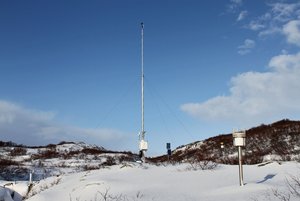Litla-Skarð

Address
Litla Skarð Field Stationc/o Hlynur Óskarsson
Agricultural University of Iceland
Hvanneyri
311 Borgarnes
Iceland
Station manager
Hlynur ÓskarssonStation Features
Opening year: 1996 Status: OpenFacilities
Station name and owner
Litla-Skarð; is not a typical research station but a bio-monitoring site. The site is operated jointly by the Agricultural University of Iceland, the Icelandic Institute of Natural History, the Icelandic Meteorological Office, the Environmental and Food Agency of Iceland, and the Iceland Forest Service.
Location
The Litla-Skarð; bio-monitoring area is located in the lowlands of western Iceland (64°43'N, 21°37'W), about 38 km from the shore-line and 100 km north of Reykjavik.
Climate data
Grey colours are WMO Climate Normals including maximum and minimum values. Blue colours are individual years.
Climate data for the stations where extracted via Copernicus Climate Data Store, from the global gridded reanalysis product:
ERA5 monthly averaged data on single levels from 1940 to present.
Description and source code: Roemer J.K. 2023. https://doi.org/10.5281/zenodo.10214922
Data Source: Hersbach et al. 2023. Copernicus Climate Change Service (C3S) Climate Data Store (CDS), https://doi.org/10.24381/cds.f17050d7
Biodiversity and natural environment
The Litla-Skarð area exhibits birch shrubs, moss heaths, sedge mires, grassland as well as, sparsely vegetated fell fields. Also a small lake is found within the area. In total, 101 vascular plant species and 19 moss species have been recorded at the site. Birds dominate the vertebrate fauna with 22 species recorded in the area. Most notable of these are whooper swans (<em>Cygnus cygnus</em>), great northern divers (<em>Gavia immer</em>), and redwings (<em>Turdus iliacus</em>) in summer; snow bunting (<em>Plectrophenax nivalis</em>) in winter and raven (<em>Corvus corax</em>) and ptarmigan (<em>Lagopus muta</em>) year around. Three species of mammals occur at the site: Arctic fox (<em>Alopex lagopus</em>), American mink (<em>Mustela vison</em>), and wood mouse (<em>Apodemus sylvaticus</em>). Two species of fish occur in the lake: three-spined stickleback (<em>Gasterosteus aculeatus</em>) and brown trout (<em>Salmo trutta</em>).
History and facilities
The Litla-Skarð site was designated as a bio-monitoring area in 1996. Litla-Skarð is an old, lowland farm. The site is now owned by the Iceland Forest Service. In the past most of the area was used for grazing livestock, mainly sheep. The site has not been grazed since 1985. Afforestation at the site is very limited and disturbance level from human activities is low. The total land area of the Litla-Skarð bio-monitoring area is 3 km<sup>2</sup> with an elevation of 60-230 m a.s.l. At Litla-Skarð there are no research buildings or laboratories, and permanent staff is not located at the site. However, accommodation and laboratory space are available at the campus of the Agricultural University of Iceland in Hvanneyri, 27 km away from the site.
General research and databases
Litla-Skarð is a national site for the International Cooperative Program on Integrated Monitoring of Air Pollution Effects on Ecosystems (ICP IM). The main research emphasis till now has been on chemistry of precipitation, climate, and hydrology. A vegetation inventory has been carried out at the site, and the main vegetation and soil types have been mapped. The research is mostly confined to a 560000 m<sup>2</sup> catchment area. Automated weather and hydrological stations were set up at the site in 2000. Existing data bases include climatic records, data on catchment hydrology and water chemistry, as well as limited biological records.
Station Monitoring
Human dimension
Before the Litla-Skarð area was established as a research and monitoring site in 1996, farmsteads and sheep grazing dominated the land-use. Currently there are no farms in the area and domestic grazing animals have been absent for over 20 years.
Access
Litla-Skarð is reached by car throughout the year. It is located by the main central highway, c. 100 km from Reykjavik. Keflavik International Airport is situated about two hours drive from the site.

